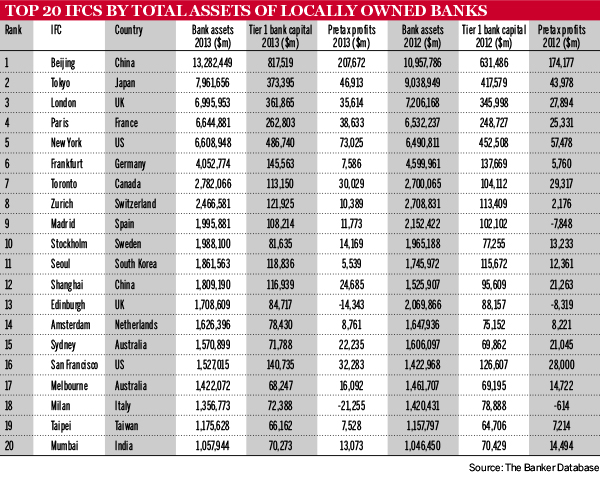As most lenders start preparing their annual financial statements, The Banker has taken a look at the size of the banking sector in financial centres around the world, according to the latest available data. Ranked by total assets of banks headquartered in each city, the list also gives a comparison with financial results a year earlier.
Editor's choice
Beijing leads the table with total $13,283bn of banking assets, almost twice as much as second and third best: Tokyo’s $7962bn and London’s $6996bn, respectively. The Chinese financial centre had also expanded the most with assets $2325bn larger than the previous year. This is in stark contrast to financial centres from the developed world, where the size of the banking sector shrank or kept close to past levels.
Shrinking centres
Out of the nine European hubs in the top 20 list, the only two that have not reduced in size are Paris and Stockholm. In North America, New York, Toronto and San Francisco displayed some growth but only by small margins.
While large lenders based in developed countries continue to retrench in core markets and shed assets, the expansion of emerging market banks has become sizeable. This is true particularly in Asia, with five emerging financial centres from the region peppering the table. Scrolling down the list, Seoul is the world’s 11th largest banking hub, followed by Shanghai in 12th place and Taipei and Mumbai in 19th and 20th positions, respectively.
Beijing also leads by pre-tax profits, almost three times higher than New York, the second largest financial centre by that measure. On an aggregate level, Madrid-based banks moved out of the red and closed in profit in 2013, while Edinburgh – home to Royal Bank of Scotland – and Milan exacerbated their aggregate banking losses.
The Italian financial centre suffered the biggest hit, with aggregated losses going from $614m to $21.255bn. This was explained mostly by the write-down of riskier non-performing loans in anticipation of last year’s asset quality review by the European Central Bank.
Mirroring the macroeconomic misfortunes of Brazil and Russia – part of the once hopeful BRIC group of emerging countries alongside China and India – neither São Paulo nor Moscow feature in the top 20 ranking. Aggregate assets of banks based in those hubs, however, are not too far behind Mumbai’s. These figures are $957bn for Moscow and $940bn for São Paulo.








